Pinterest, founded in 2010, quickly became the visual social bookmarking service of the web. And, like the very best social platforms do, it invented a verb: pinning. Facebook users “like”, Twitter users “tweet”, and Pinterest users “pin”.
Pinning says “I want this.” It’s aspirational. People pin products they’d love to own, recipes they want to cook, and projects they want to tackle. Emma Stone pins about what she wishes her empty, 1-bedroom apartment looked like. “Pinterest Stress” is being blamed for pressuring moms to be increasingly creative in everything from food to parties. The platform has been so successful at getting users excited about tackling creative projects that it has spawned a sub-genre where users share their hilarious attempts at Pinterest perfection.
Pinning is aspirational, which means that data on pins is data on people’s aspirations. In this article, we’re going to explore the dataset of 50,000 random pinners and their pins. We’ll be using this data to understand user engagement, the aspirations of pinners, and what this means for the future of Pinterest.
Make sure to read all the way to the end—the final section on user engagement blew us away. Did you know that 84% of female pinners are still active in their fourth year? That’s some serious user retention.
A note on the data: We got this data directly from public pages on pinterest.com and analyzed it in RJMetrics. If you’re interested in running an analysis like this for your business, you can try RJMetrics for free.
Who’s Pinning
It’s conventional wisdom that most Pinterest users are women, and we wanted to see if the data agreed:
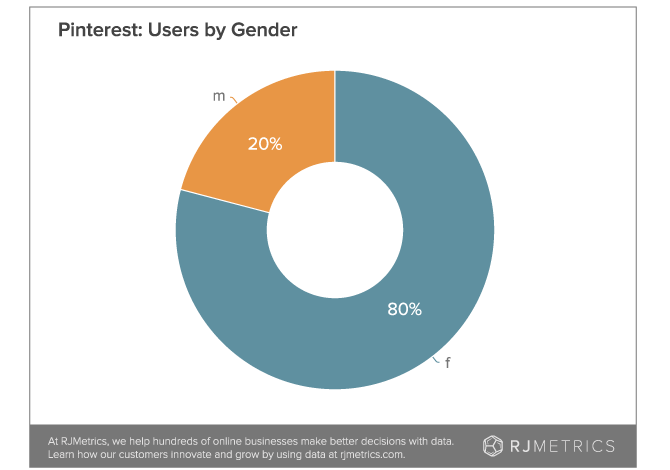
Pinterest users are 80% female and 20% male. In addition, female Pinterest users are far more active than their male counterparts. 92% of all pins are made by women:
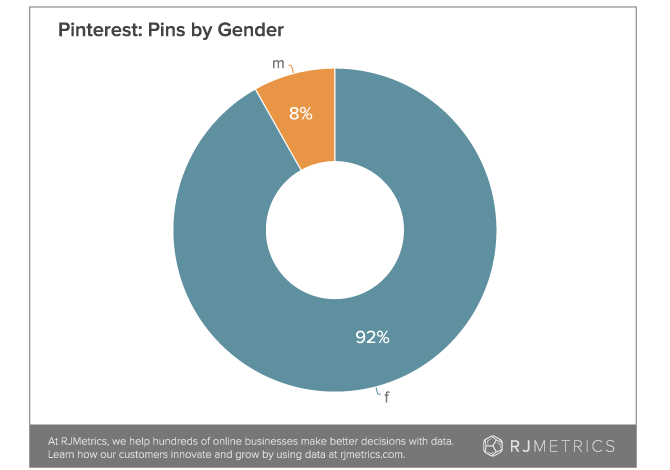
While conventional wisdom isn’t always correct, it looks like this time it’s dead on. We couldn’t help wondering whether or not this has always been the case, or whether Pinterest demographics have evolved over time. Turns out that the percentage of pins made by men has been consistently declining since July of 2011, the first month for which we have reliable data:
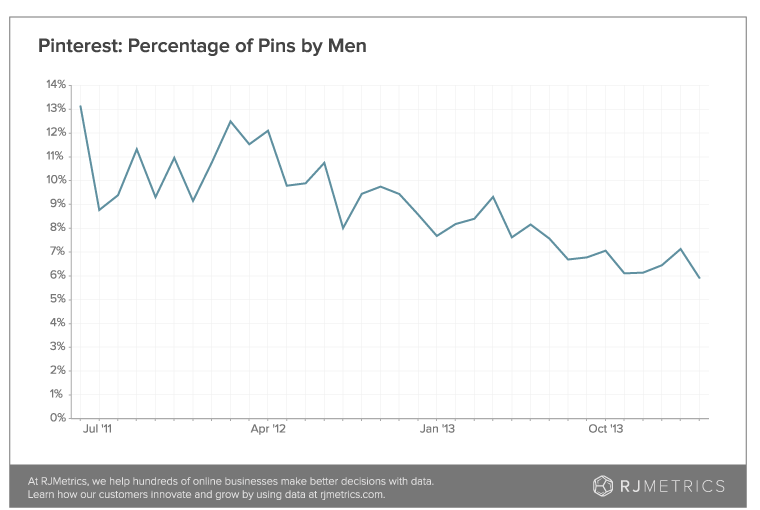
While Pinterest has always been dominated by women, their percentage of total activity has actually grown from 87% to 94% over the past (almost) 3 years. As of April 2014, there are 15x more pins by women than by men.
A note on the data: Pinterest doesn’t share gender data publicly, but they do share users’ names. About 75% of users supply a name that maps to a name as recognized by the US Census Bureau. We mapped name data to census data to arrive at gender.
What Are Women Pinning?
It’s clear that women dominate Pinterest, and we wanted to get a better sense of the aspirations that they are sharing via Pinterest. Our first stop was to look at raw activity level. Over the past year, the average active female user has made 158 pins.
Next, we explored what women are pinning about. As a starting place, we looked at the most popular categories on Pinterest. 20% of pins fall in the Food and Drink category, 12% are DIY & Crafts, and 11% are Home Decor.
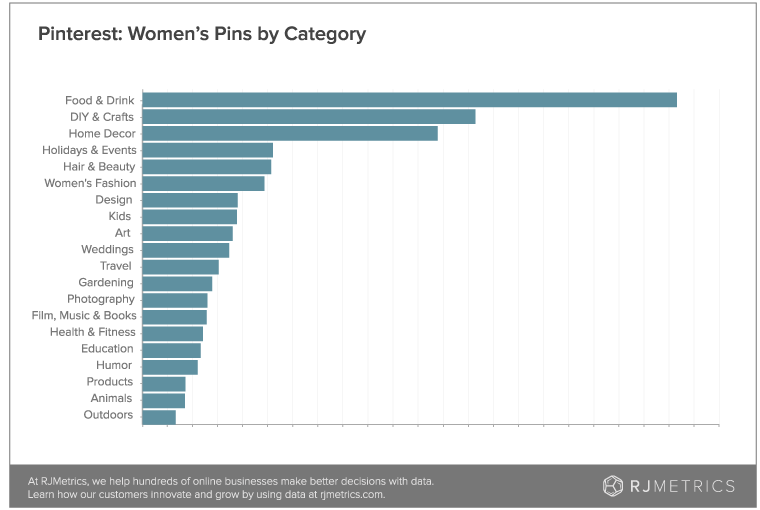
On its own, this data isn’t very surprising. But it has some important implications for the brands that are currently succeeding on Pinterest.
Aspirational Brands and Pinterest
Every pin links to a website, using this we take a look at what brands female pinners are into by looking at these URLs. This gets good when we weed out the user-generated content sites (i.e., Blogspot, Tumblr, Flickr) and focus on rich pins containing product data. Here’s the data, ranking domains by number of repins:
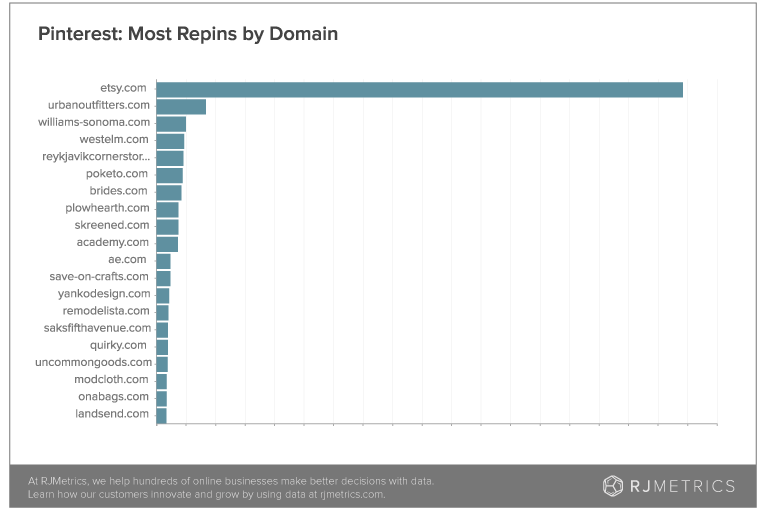
Etsy is crushing it. Our first reaction was to wonder what Etsy was doing right on their product pages to encourage pinning, but it turns out the on-site Pin It button only accounts for 8% of total pins. 67% of all Etsy pins come from the Pinterest bookmarklet.
This data indicates that the Etsy-Pinterest advantage has less to do with their on-site optimization and more to do with the fact that both Etsy’s brand (unique and homemade) and product offering (Home Decor, Food & Drink, DIY) align with the aspirations of Pinterest users. Other brands doing well on Pinterest—Urban Outfitters, Williams-Sonoma, and West Elm—show similar fit in both how they present their brands and their product lines.
Another way to look at brands excelling on Pinterest is to look at the most followed boards. We were surprised to see that Lowe’s boasts the number one board on all of Pinterest, boasting 3.4MM followers as of this writing. While lowes.com isn’t a one of the most pinned sites, Lowe’s social media team is doing a great job building brand awareness via Pinterest.
When Are Women Pinning?
Category-level data has important implications for brands, and it also tells us something about how Pinterest fits into the lives of its users. When we look at the data on a month-by-month basis we start seeing distinct trends in seasonal aspirations emerge. Pins to holiday categories start rising in August, gardening pins start increasing as early as December, and health and fitness trends are on the rise in the early part of the year.
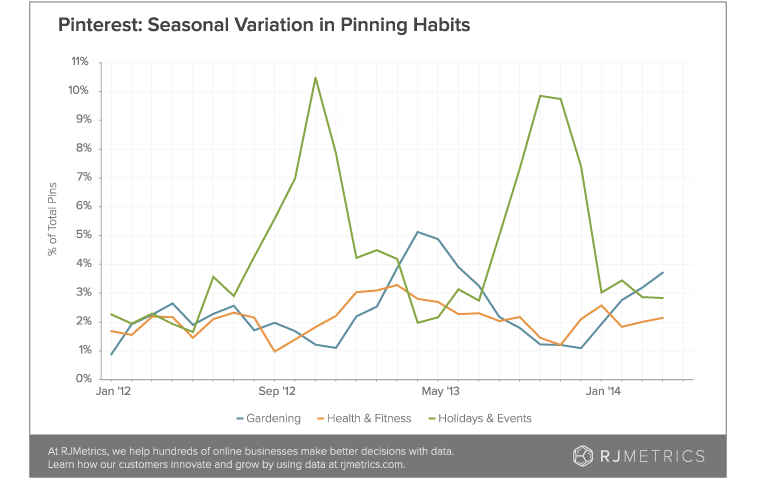
We can zoom in even further and look at how pinning activity shifts by the hour. Here’s where we start to understand how firmly embedded Pinterest is in the lives of its users. First, we see pinning increase steadily throughout the day.
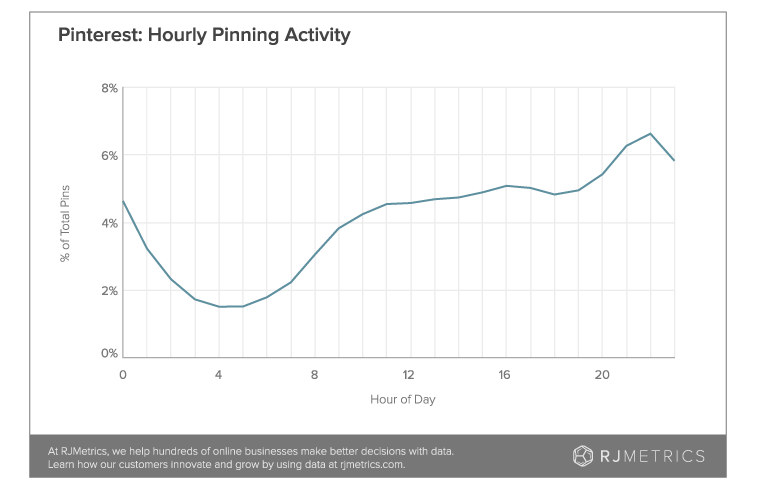
Second, diving in a level deeper, we see that women’s top 5 categories show almost no difference in timing. Little pinning happens at night, steady pinning throughout the day, and a spike in the evening.
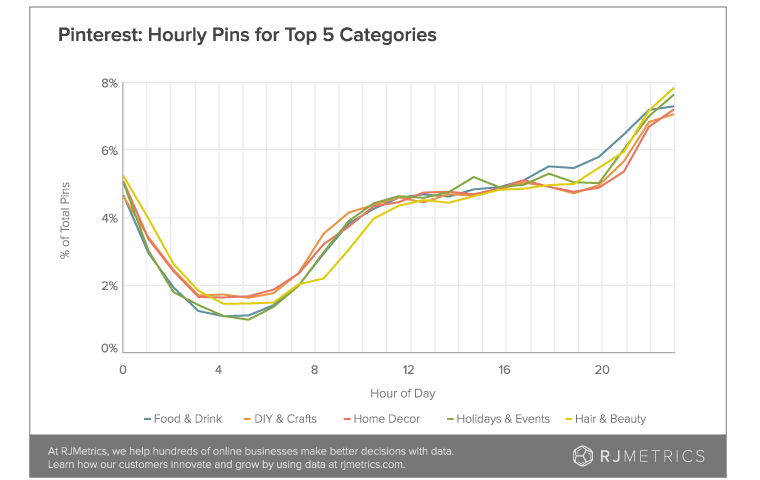
32% of all pinning happens during during the core part of the work day, from 10am – 4pm, whereas 18% of all pinning happens in the evening, 9pm – midnight. What makes this data interesting is when we look at it compared to other social networks. Facebook traffic falls steadily after 3pm, as does Twitter activity.
The Future of Pinterest
Our data so far has revealed how embedded Pinterest is in the lives of its users today, but we really want to know what the future holds. What’s next? A little over two years ago when we first analyzed Pinterest data, we were astounded by its low attrition rates. We wanted to see if these numbers were still holding up:
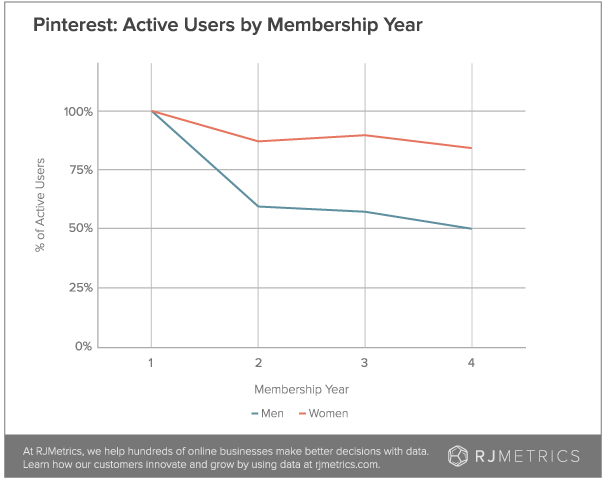
Incredible. While we see a drop off in male users, 84% of female pinners are still pinning in their fourth year using the platform. What’s even more interesting is their level of activity: it turns out that female users only get more active with time:
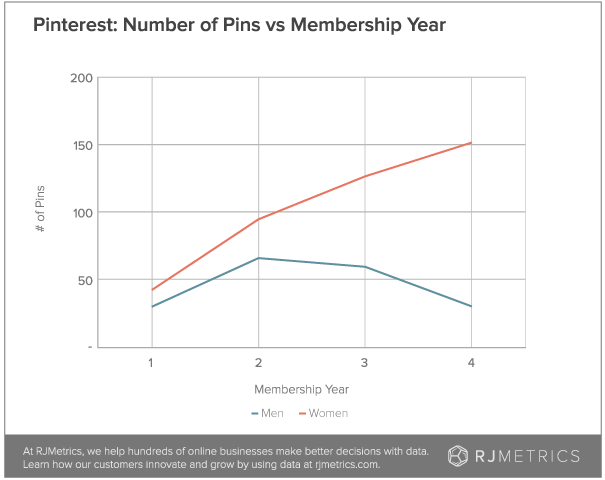
Again, we see a drop-off in male pinning activity, but look at the women. Female users are pinning more every year they use Pinterest. While the average female user posts 42 pins in year 1, by year 4 she is up to 152! If you set out to build a habit-forming product, that is exactly the type of trend you’re looking for.
This trend in user activity is undoubtedly a key ingredient in justifying a $3.8B valuation. The remaining unknown is monetization, but it’s clear that the wheels are already turning.
In late April Pinterest unveiled its new Guided Search feature. This new functionality means that when a user searches “books” they see targeted sub-categories like “bookshelves” or “books to read.” This represents a major shift for Pinterest. The platform is evolving from a place to store your aspirations to a discovery platform that can help you find what you didn’t know you were looking for.
This is a new world for Pinterest, and the data indicates they are set up to succeed. Armed with best-in-class user retention and engagement, and with women making 85% of consumer purchasing decisions, Pinterest is set up to be a major player in online commerce. Is it possible that it will dethrone Google as the starting place for product search?
Fortunately, all the data is public. We’ll be sure to check back in as the story plays out.
